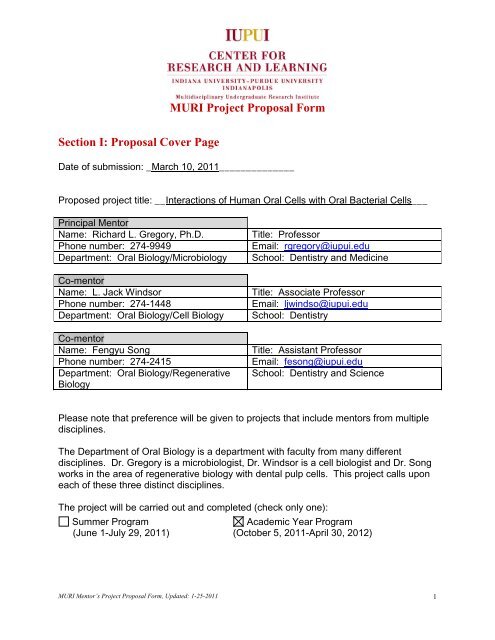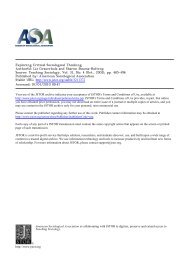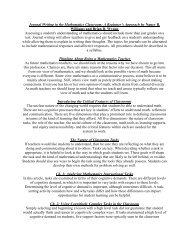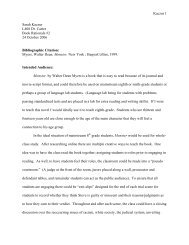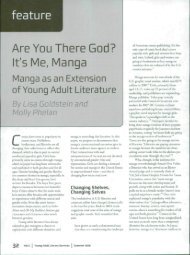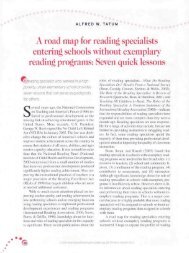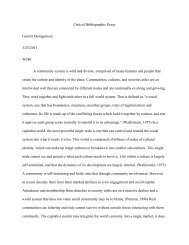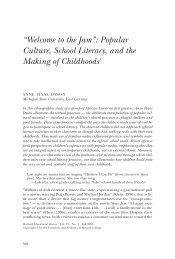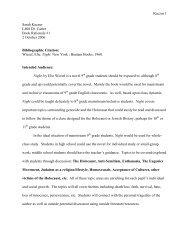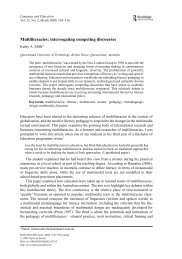Proposal - Oncourse - Indiana University
Proposal - Oncourse - Indiana University
Proposal - Oncourse - Indiana University
Create successful ePaper yourself
Turn your PDF publications into a flip-book with our unique Google optimized e-Paper software.
MURI Project <strong>Proposal</strong> Form<br />
Section I: <strong>Proposal</strong> Cover Page<br />
Date of submission: _March 10, 2011______________<br />
Proposed project title: __Interactions of Human Oral Cells with Oral Bacterial Cells___<br />
Principal Mentor<br />
Name: Richard L. Gregory, Ph.D.<br />
Phone number: 274-9949<br />
Department: Oral Biology/Microbiology<br />
Co-mentor<br />
Name: L. Jack Windsor<br />
Phone number: 274-1448<br />
Department: Oral Biology/Cell Biology<br />
Co-mentor<br />
Name: Fengyu Song<br />
Phone number: 274-2415<br />
Department: Oral Biology/Regenerative<br />
Biology<br />
Title: Professor<br />
Email: rgregory@iupui.edu<br />
School: Dentistry and Medicine<br />
Title: Associate Professor<br />
Email: ljwindso@iupui.edu<br />
School: Dentistry<br />
Title: Assistant Professor<br />
Email: fesong@iupui.edu<br />
School: Dentistry and Science<br />
Please note that preference will be given to projects that include mentors from multiple<br />
disciplines.<br />
The Department of Oral Biology is a department with faculty from many different<br />
disciplines. Dr. Gregory is a microbiologist, Dr. Windsor is a cell biologist and Dr. Song<br />
works in the area of regenerative biology with dental pulp cells. This project calls upon<br />
each of these three distinct disciplines.<br />
The project will be carried out and completed (check only one):<br />
Summer Program<br />
Academic Year Program<br />
(June 1-July 29, 2011) (October 5, 2011-April 30, 2012)<br />
MURI Mentor’s Project <strong>Proposal</strong> Form, Updated: 1-25-2011 1
Section II: Student Request Page<br />
Total number of students requested: ______5_______<br />
(Note: The total number of students must exceed the number of mentors by two)<br />
Total Number of freshmen and/or sophomores to be recruited: _______2-3___________<br />
Disciplines or majors of students (preference will be given to projects that include at least two<br />
disciplines or majors): _Biology, Chemistry, Pre-Dental, Pre-Medical, SPEA, Liberal Arts__<br />
Skills expected from students: __Good analytical skills, persistence and strong attention to detail<br />
________________________________________________________________________<br />
________________________________________________________________________<br />
Names of students you request to work on this project.<br />
(Mentors are invited to recommend students that they would prefer to work on the proposed<br />
project. Please provide an email address and a rationale; for example, a student may have an<br />
essential skill, may already be working on a similar project, or may be intending to apply to<br />
graduate school to pursue the same area of research.)<br />
The Center for Research and Learning will consider the students requested below, but cannot<br />
guarantee placement of specific students on teams.<br />
Name of Student: Student’s Email: Rationale:<br />
1)__Jessica Morgan_ morgan28@umail.iu.edu_ Already working on a similar project_<br />
2)_Charla McGough_cmcgough@imail.iu.edu<br />
_Already working on a similar project<br />
3)_________________ ______________ ________________________<br />
4)_________________ ______________ ________________________<br />
5)_________________ ______________ ________________________<br />
6)_________________ ______________ ________________________<br />
MURI Mentor’s Project <strong>Proposal</strong> Form, Updated: 1-25-2011 2
Section III: Body of <strong>Proposal</strong><br />
(A maximum of 5 pages is allowed for answers to questions 1-10.)<br />
Objectives: Smokers have increased periodontal disease (caused by the anaerobic<br />
Porphyromonas gingivalis) and dental caries (caused by the facultative anaerobe<br />
Streptococcus mutans). These bacteria are known to bind to or interact with gingival<br />
epithelial cells and gingival fibroblast cells-P. gingivalis contributing to periodontal<br />
disease and dental pulp cells-S. mutans causing dental root caries and endothelial<br />
cells-S. mutans associated with atherosclerosis. However, little is known about the<br />
effects of tobacco directly on these bacteria on their ability to affect these human cells<br />
and to cause disease. It is our hypothesis that tobacco up-regulates the expression of<br />
certain virulence genes and proteins to increase the pathogenic potential of P. gingivalis<br />
and S. mutans. The objectives of this research are to investigate the effects that<br />
nicotine and tobacco-treated bacterial cells have on these human cells with<br />
respect to their release of pro-inflammatory cytokines and matrix<br />
metalloproteinases (MMP). This will contrast with our 2011 summer proposal where<br />
students will focus on the effects of virulence factors from tobacco-treated bacteria<br />
secreted into culture supernatant on several human cell types and the subsequent<br />
release of pro-inflammatory cytokines and MMP. In addition, we will add analysis of<br />
endothelial cells. Each student will grow bacteria in the Gregory lab and then move<br />
after about 2-3 months to either the Windsor or Song labs to assess the effects of the<br />
bacterial cells on human cells.<br />
Significance: The project will begin to address the important roles these bacteria play<br />
in periodontal disease and caries of smokers. The long term goal is to develop<br />
treatment modalities to reduce the effects of smoking on periodontal disease and caries.<br />
Student Opportunity: Students will have the opportunity to be present at the<br />
beginning of this exciting project. They will be able to experience at least two different<br />
laboratories. We have not examined the effects of these bacterial cells on human oral<br />
cells previously and expect that this will lead to information that may elucidate additional<br />
mechanisms that the bacteria use in causing disease.<br />
Research Methodology: S. mutans UA159 and P. gingivalis ATCC 33277 will be<br />
incubated in Tryptic Soy broth (TSB) or modified Schaedler broth, respectively,<br />
with optimal concentrations of cigarette smoke condensate (CSC), nicotine and<br />
dissolvable smokeless tobacco (DST) in the Gregory lab. These optimum<br />
concentrations will be determined from previous student data by using the<br />
concentrations that increase certain bacterial virulence factors such as S. mutans<br />
growth, biofilm formation, and antigen I/II expression, and proteolytic activity for P.<br />
gingivalis. Typically, these concentrations are 0.25 mg of CSC/ml, 0.5 mg of<br />
nicotine/ml and 3.3% for DST. The cultures will be grown in the presence of the<br />
tobacco products for 24 h at 37 o C in 5% CO 2 and centrifuged at 10,000 x g for 15 min.<br />
MURI Mentor’s Project <strong>Proposal</strong> Form, Updated: 1-25-2011 3
The cell pellet will be washed three times with sterile saline and resuspended in saline<br />
containing 0.05% formaldehyde to kill the bacteria. The cells will remain in<br />
formaldehyde for 3 days at room temperature and then washed three times to remove<br />
the formaldehyde. The cells will be standardized to 0.5 absorbance at 540 nm and<br />
stored at 4 o C until used.<br />
The various S. mutans cells will be used in Dr. Song's lab to assess the ability of the<br />
S. mutans cells to affect human pulp cell release of pro-inflammatory and antiinflammatory<br />
cytokines, as well as MMP expression. In addition, the effects of the<br />
S. mutans cells will be examined for the ability to affect pulp cell growth. It is<br />
hypothesized that S. mutans cells treated with tobacco will increase pro-inflammatory<br />
cytokines and MMPs over that untreated with tobacco. This will provide further<br />
confirmation of the effect of S. mutans and smoking on dental caries and periapical<br />
infections.<br />
Human pulp cells were isolated from sound teeth extracted for orthodontic purpose with<br />
IUPUI IRB approval. The cells were maintained as cell lines in the laboratory and will<br />
be used between passage 3 to 8 for the following experiments. After the various<br />
number of S. mutans are incubated with 7.5 x 10 4 human pulp cells/well of 6-well tissue<br />
culture plates for 72 h, the human pulp cells will be evaluated for their proliferation<br />
utilizing water-soluble tetrazolium salt-1 assay (WST-1, Roche Allied Science,<br />
<strong>Indiana</strong>polis, IN) following the manufacturer’s instructions. The conditioned media will<br />
then be collected and resolved on zymogram gels containing 1 mg/ml of gelatin with or<br />
without any specific inhibitors in order to analyze the MMP expressions and activities<br />
under the influence of S. mutans cells. The cytokine expression will be evaluated by<br />
semi-quantitative reverse transcriptase polymerase chain reaction (RT-PCR) after the<br />
RNA is collected from treated or untreated human pulp cells. The interaction between<br />
S. mutans and dental pulp cells will be evaluated by the Bactect staining (Invitrogen,<br />
Fazzi, 2002) following the manufacture protocol. The intensity of the fluorescent signal<br />
will be measured and analyzed under the microscope. The number of bacterial cells<br />
adhering to the human cells will be counted. The expression of major pro-inflammatory<br />
(IL1, TNFα, IL6, IL8, MIP-1, GRO and GROα) and anti-inflammatory (IL4, IL10, and<br />
IL13) cytokines will be examined by RT-PCR after collecting the total RNA from the<br />
treated and untreated pulp cells and using cytokine microarrays (RayBiotech). Each<br />
experiment will be performed at least three times and One-way ANOVA will be used to<br />
detect statistical differences between different treatment groups.<br />
The various P. gingivalis cells will be used in Dr. Windsor's lab to assess the ability of<br />
the P. gingivalis cells to affect human gingival epithelial and gingival fibroblast cell<br />
release of pro-inflammatory and anti-inflammatory cytokines, as well as MMP<br />
expression. In addition, the effects of the P. gingivalis cells will be examined for the<br />
ability to affect epithelial and fibroblast cell growth. It is hypothesized that P. gingivalis<br />
cells treated with tobacco will increase pro-inflammatory cytokines and MMPs over that<br />
untreated with tobacco. This will provide further confirmation of the effects of<br />
P. gingivalis and smoking on periodontal disease. Identical methodology as described<br />
above for pulp cells will be used for human gingival epithelial, gingival fibroblast and<br />
MURI Mentor’s Project <strong>Proposal</strong> Form, Updated: 1-25-2011 4
human umbilical vein endothelial cells (HUVEC). In addition, the effects of the tobaccotreated<br />
P. gingivalis cells on cell-mediated collagen degradation will be assessed.<br />
Team Communication and Organization:<br />
a. The Principal Mentor will take the lead in supervising students to initially identify<br />
the specific project they will work on and to coordinate the team meetings and ensure<br />
student attendance at all required research seminars and programs;<br />
b. The Principal and Co-Mentor(s) will be available to provide students assistance in<br />
design of specific studies and experiments, to meet regularly with each student to plan<br />
experiments and analyze data and prepare research reports and presentations;<br />
c. Graduate students and postdocs will train students in some of the laboratory<br />
assays;<br />
d. All students in the project will grow bacteria in the Gregory lab and assess the<br />
effects of the bacterial cells in the Windsor or Song labs on cytokine and matrix<br />
metalloproteinase expression and measure their attachment.<br />
e. All students will prepare their research for presentation in a poster or oral format.<br />
These studies will complement others ongoing in the Tobacco Cessation and<br />
Biobehavioral Group. The proposed project seeks the pathophysiology of tobacco and<br />
its related chemicals on human oral tissues from multiple perspectives, such as<br />
microbiology, cell biology, molecular biology, biochemistry, immunology, and<br />
biobehavior and enables us to begin to identify the effects of blocking these tobaccoassociated<br />
pathologies. Students will work closely with the three MURI faculty (Drs.<br />
R.L. Gregory, L.J. Windsor and F. Song), as well as with postdoctoral and Ph.D.<br />
students working on other tobacco-related projects. Students will meet individually with<br />
their MURI faculty at least 2-3 times a week as well as regular lab meetings to discuss<br />
experimental design and research data. MURI students working in the same lab are<br />
expected to collaborate on their projects as some of the same skills will be used in their<br />
projects. Many MURI mentors host social outings at their house to foster a greater<br />
feeling of teamwork. In addition, all students and MURI faculty will meet together once<br />
a month for each student to present his/her project and data. It is expected that all five<br />
MURI students will have a basic understanding of each others’ projects. This will build<br />
camaraderie among the MURI students and provide them with a certain level of comfort<br />
in discussing their project to a group. All MURI students, dental students and PhD<br />
students meet every other Tuesday evening in our Student Research Presentation<br />
Program (SRPP) to take turns presenting their work in front of their peers as well as a<br />
few faculty members. This gives the MURI students feedback in an informal setting that<br />
is preferred over a larger format. Students approved for this project will be given<br />
background readings specific to the laboratories they will primarily be working in (see<br />
references 1-9 as examples) before their MURI project begins. Students from various<br />
backgrounds (Science-Biology, Chemistry, Pre-Dental and Pre-Medical, SPEA, Liberal<br />
Arts) are desired as it allows a diversification of ideas. All of the specific projects to be<br />
conducted by MURI students are multidisciplinary in nature. Many SPEA students<br />
would benefit because of their potential interest in environmental and health affairs<br />
MURI Mentor’s Project <strong>Proposal</strong> Form, Updated: 1-25-2011 5
connected with a focus on tobacco in this project. Accepting students into this project<br />
from non-science backgrounds (Liberal Arts) allows them to understand a different area.<br />
Expected Outcomes and Benefits: Attempts have been made to understand the<br />
mechanism(s) of how tobacco influences human oral cells and microorganisms. The<br />
project is designed to systemically analyze those effects from different perspectives and<br />
be able to combine the results of the oral cells and bacteria together to have a complete<br />
picture regarding the tobacco’s effects on the oral cavity. The results from this<br />
proposed project will be helpful to support ongoing projects in Tobacco Cessation and<br />
Biobehavioral Group, which are pilot studies needed for NIH grant applications in the<br />
near future. In addition, students will acquire sufficient knowledge to be conversant in<br />
their specific field of research and master the necessary skills to conduct research and<br />
present their work with the platform provided from this proposed project in the dental<br />
school’s research environment. All students will be expected to present their research<br />
at all required MURI and/or UROP workshops, as well as our school’s annual Research<br />
Day and the IUPUI campus Research Day held every April. We will ask the students to<br />
participate in the two Research Days even though they would have completed their<br />
research in the summer prior to Research Day because many of the students applying<br />
to our laboratories for research projects are pre-dental students. All students conducting<br />
research at our school participate in a biweekly SRPP and the MURI Fellows would be<br />
expected to present their work at the end of the summer research period. The projects<br />
conducted during the summer will significantly differ from our previous MURI projects in<br />
that these individual experiments will measure the effect of bacterial cells directly on the<br />
human cells. With the knowledge gained from this proposed project, information for<br />
understanding how tobacco affects the oral cavity can be obtained. Building on this<br />
knowledge, future strategies for intervention with tobacco on oral pathological conditions<br />
can be constructed. This proposed project will also help to build the base for future NIH<br />
grants. Moreover, students in this program would benefit by gaining important research<br />
skills such as enhancing their knowledge of the scientific method and other skills<br />
specific to their projects as well as interact with the MURI faculty and other associated<br />
research personnel (graduate students and technicians). One of the tangible benefits<br />
will be that each student will be able to record at least one published abstract (MURI<br />
poster presentation and/or IUPUI and IUSD Research Days) on their resume and able<br />
to verbally present their work before a group of faculty and other students.<br />
Time Table: In the first week, students would be introduced to all personnel in the<br />
laboratory, department and to other MURI faculty and students, assigned desk space<br />
and a lab coat and take required online training courses offered by IUPUI in laboratory<br />
safety and blood borne disease without regard to the type of research to be conducted<br />
(see time line). Also in the first week, students will be given additional reading material<br />
on their topic and receive detailed instruction in the basic aspects of the laboratory<br />
procedures. Subsequent weeks will be devoted to experimental design and pilot<br />
experiments. By the second month of the project, students should be fairly independent<br />
MURI Mentor’s Project <strong>Proposal</strong> Form, Updated: 1-25-2011 6
in the experimental procedures they have been instructed on and conducted preliminary<br />
pilot experiments. It is anticipated that the bulk of the research data that will be reported<br />
will be obtained in the latter half of the 9 month program. The last month of the program<br />
will be devoted to completion of any remaining experiments and writing the final report<br />
of the project. In addition, students will prepare a poster throughout the entire program<br />
with the introduction and methods sections being written early in the project and the<br />
results and discussion sections being prepared at the end of the program.<br />
ACTIVITIES DURING EACH WEEK of PROGRAM<br />
ACTIVITY 1 2 3 4 5 6 7 8 9<br />
Introduction X X<br />
to Lab Proc.<br />
Learn Exp.<br />
X X<br />
Procedures<br />
Experiments X X X X<br />
in Gregory<br />
Lab<br />
Experiments<br />
X X X X X X<br />
in Windsor<br />
and Song<br />
Labs<br />
Completion<br />
X<br />
of Exp.<br />
Written<br />
Report<br />
X<br />
Itemized Budget: Total $2,000. The supply budget consists of an equal division of the<br />
funds among each student (for 5 students, each would be able to utilize up to<br />
$400/each for laboratory supplies, reagents or small equipment).<br />
Sustainment of Research Project: We are currently developing an NIH grant in<br />
consultation with NIGMS officers to provide support after this MURI project. We will use<br />
data generated from the MURI students as preliminary data for this grant submission.<br />
Risk Management:<br />
Please check any risk assurances that apply to this proposal:<br />
Animals (IACUC Study #): _________________<br />
Human Subjects (IRB Study #): _0304-58, NS0805-human fibroblast and epithelial cells and<br />
NS0905-human pulp cell studies)__<br />
r-DNA (IBC Study #): _____________________<br />
Human Pathogens, Blood, Fluids, or Tissues must be identified if used: ______<br />
MURI Mentor’s Project <strong>Proposal</strong> Form, Updated: 1-25-2011 7
Section IV: References/Bibliography (insert 1-2 pages as needed)<br />
1. Zheng, C., and R. Gregory. 2008. The effect of nicotine and cotinine on the growth of<br />
Streptococcus mutans and the protein expression. Abstracts of the American Society for<br />
Microbiology.<br />
2. Zheng, C. and R.L. Gregory. In vitro effect of cigarette smoking condensate on the growth and<br />
sucrose-dependent adherence of Streptococcus mutans and Streptococcus gordonii. Caries Res.<br />
(manuscript in revision).<br />
3. Windsor, L.J., E. Allam and R.L. Gregory. Cigarette smoke toxicity and oral health. In:<br />
Cigarette Smoke Toxicity - Linking Individual Chemicals to Human Diseases. D. Bernhard (ed.).<br />
Wiley-VCH Verlag GmbH & Co. KGaA (pub.) (submitted).<br />
4. Gregory, R.L., J.C. Kindle, L.C. Hobbs, T. VanTo and H.S. Malmstrom. 1990. Effects of<br />
smokeless tobacco on the ability of secretory component to bind to the IgA/J chain<br />
complex. Human Antibodies and Hybridomas 1:126-131.<br />
5. Gregory, R.L., J.C. Kindle, L.C. Hobbs and H.S. Malmstrom. 1991. Effect of smokeless<br />
tobacco use on mucosal immune factors. Archs. Oral Biol. 36:25-31.<br />
6. Zhou, J., B.L. Olson, and L.J. Windsor. 2007. Nicotine increases the collagen-degrading<br />
ability of human gingival fibroblasts. J. Periodont. Res. 42:228-235.<br />
7. Almasri, A., K. Wisithphrom, L.J. Windsor, and B.L. Olson. 2007. Nicotine and<br />
lipopolysaccharide affect cytokine expression from gingival fibroblasts. J. Periodont.<br />
78:533-541.<br />
8. Song, F., A.S. Bergdoll, and L.J. Windsor. 2006. Temporomandibular joint synovial<br />
fibroblasts mediate serine proteinase dependent Type I collagen degradation. Biochim. et<br />
Biophys. Acta. 1760:1521-1528.<br />
9. Song, F., K. Wisithphrom, J. Zhou, and L.J. Windsor. 2006. Matrix metalloproteinase<br />
dependent and independent collagen degradation. Frontiers in Bioscience. 11:3100-3120.<br />
10. Rainey, C.L., P.A. Condor and J.V. Goodpaster. 2011. Chemical characterization of<br />
dissolvable tobacco products promoted to reduce harm. J. Agricultural and Food<br />
Chemistry (in press).<br />
11. Fazii, P., E. Ciancaglini and G. Riario Sforza, Differential Fluorescent Staining Method<br />
for Detection of Bacteria in Blood Cultures, Cerebrospinal Fluid and Other Clinical<br />
Specimens, European Journal of Clinical Microbiology & Infectious Diseases 21:373-378<br />
Section V: CVs/Resumes (insert 2 pages per mentor for a maximum of 6 pages)<br />
See attached 2 page NIH-style biosketches for Drs. Richard Gregory, L. Jack Windsor and<br />
Fengyu Song.<br />
MURI Mentor’s Project <strong>Proposal</strong> Form, Updated: 1-25-2011 8
NAME<br />
Richard L. Gregory<br />
eRA COMMONS USER NAME<br />
RGREGORY<br />
BIOGRAPHICAL SKETCH<br />
Provide the following information for the key personnel and other significant contributors.<br />
Follow this format for each person. DO NOT EXCEED FOUR PAGES.<br />
POSITION TITLE<br />
Professor of Oral Biology and Director of PhD<br />
Program<br />
EDUCATION/TRAINING (Begin with baccalaureate or other initial professional education, such as nursing, and include postdoctoral training.)<br />
INSTITUTION AND LOCATION<br />
DEGREE<br />
(if applicable)<br />
YEAR(s)<br />
FIELD OF STUDY<br />
Eastern Illinois <strong>University</strong>, Charleston, IL B.S. 1976 Med. Tech. & Chemistry<br />
Southern Illinois <strong>University</strong>, Carbondale, IL Ph.D. 1982 Microbiol. & Immunology<br />
<strong>University</strong> of Alabama at Birmingham Postdoc 1984 Mucosal Immunology<br />
A. Positions and Honors<br />
Positions and Employment<br />
1975-76 Medical Technologist, Decatur Memorial Hospital, Decatur, IL<br />
1984 Visiting Instructor, Department of Microbiology, <strong>University</strong> of Alabama, Tuscaloosa, AL<br />
1984-91 Assistant-Associate Prof. of Oral Biology, School of Dentistry, Emory <strong>University</strong>, Atlanta, GA<br />
1991-2001 Associate Professor of Oral Biology, School of Dentistry, <strong>Indiana</strong> Univ.<br />
1992-2001 Associate Professor of Pathology & Laboratory Medicine, Sch. of Medicine, <strong>Indiana</strong> Univ.<br />
1996 Visiting Scientist (Sabbatical), Dept. of Microbiol. and Mol. Genetics, Univ. of Vermont<br />
1996-2003 Director, Short-Term Health Professional Student Research Program, School of Dentistry<br />
1999-present Director, PhD Dental Science & Student Res. Programs, Sch. of Dentistry, <strong>Indiana</strong> Univ.<br />
2001-present Professor of Oral Biology, School of Dentistry, <strong>Indiana</strong> Univ.<br />
2001-present Professor of Pathology & Laboratory Medicine, School of Medicine, <strong>Indiana</strong> Univ.<br />
2001-2002 Acting Director of Research, School of Dentistry, <strong>Indiana</strong> Univ.<br />
2008-present Member, IU Center for Environmental Health and Simon Cancer Center<br />
Other Experience and Professional Memberships<br />
1987-present NIH Reviewer's Reserve<br />
1993-present Editorial Board, Clinical & Diagnostic Laboratory Immunology<br />
Honors<br />
1994 <strong>Indiana</strong> <strong>University</strong> School of Dentistry Distinguished Faculty Award for Research<br />
1996-00, 2002-3,8 <strong>Indiana</strong> <strong>University</strong> Teaching Excellence Recognition Awards<br />
2003 <strong>Indiana</strong> <strong>University</strong> School of Dentistry Outstanding Faculty Member of the Year<br />
B. Selected peer-reviewed publications (from 89 peer-reviewed publications and 213 abstracts).<br />
1. Gregory, R.L. and S.J. Filler. 1987. Protective secretory IgA antibodies in humans following oral<br />
immunization with Streptococcus mutans. Infect. Immun. 55:2409-2415. PMCID: PMC260722.<br />
2. Gregory, R.L., J.C. Kindle, L.C. Hobbs, S.J. Filler, H. Malmstrom. 1990. Function of anti-S. mutans<br />
antibodies: inhibition of virulence factors and enzyme neutralization. Oral Micro. Immun. 5:181-188.<br />
3. Gregory, R.L., J.C. Kindle, L.C. Hobbs, T. VanTo and H.S. Malmstrom. 1990. Effects of smokeless tobacco<br />
on the ability of secretory component to bind to the IgA/J chain complex. Human Antibodies and<br />
Hybridomas 1:126-131.<br />
4. Gregory, R.L., J.C. Kindle, L.C. Hobbs and H.S. Malmstrom. 1991. Effect of smokeless tobacco use on<br />
mucosal immune factors. Archs. Oral Biol. 36:25-31.<br />
5. Gregory, R.L., L. Gfell, H.S. Malmstrom. 1995. Differences in sIgA and serum antibodies to S. mutans<br />
isolates from caries-resistant and caries-susceptible subjects. Adv. Exp. Med. Biol. 371B:1149-1152.<br />
6. Fontana, M., L.E. Gfell, R.L. Gregory. 1995. Characterization of preparations enriched for S. mutans<br />
fimbriae: salivary IgA antibodies in caries- and caries-active subjects. Clin. Diagn. Lab. Immunol. 2:719-<br />
725. PMCID: PMC170228.<br />
7. Perrone, M., L.E. Gfell, M. Fontana, R.L. Gregory. 1997. Antigenic characterization of fimbriae preparations<br />
from Streptococcus mutans isolates from caries-free and caries susceptible subjects. Clin. Diagn. Lab.<br />
Immunol. 4:291-296. PMCID: PMC170521.<br />
8. Gregory, R.L., A.M.A. Rahman and D.R. Avery. 1998. Effect of restorative treatment on mutans<br />
streptococci and IgA antibodies. Ped. Dent. 20:273-277.
9. Ray, C.A., L.E. Gfell, T.L. Buller and R.L. Gregory. 1999. Interactions of Streptococcus mutans fimbrialassociated<br />
surface proteins with salivary components. Clin. Diagn. Lab. Immunol. 6:400-404. PMCID:<br />
PMC103730.<br />
10. Fontana, M., A.J. Dunipace, G.K. Stookey and R.L. Gregory. 1999. Intranasal immunization against dental<br />
caries with Streptococcus mutans enriched fimbrial preparation. Clin. Diagn. Lab. Immunol. 6:405-409.<br />
PMCID: PMC103731.<br />
11. Fontana, M., T.L. Buller, A.J. Dunipace, G.K. Stookey and R.L. Gregory. 2000. An in vitro microbial-caries<br />
model used to study the efficacy of antibodies to Streptococcus mutans surface proteins in preventing<br />
dental caries. Clin. Diagn. Lab. Immunol. 7:49-54. PMCID: PMC95821.<br />
12. Gregory, R.L. 2001. Modified immunogenicity of a mucosally administered antigen. Clin. Diagn. Lab.<br />
Immunol. 8:540-544. PMCID: PMC96097.<br />
13. Ge, J., D.M. Catt and R.L. Gregory. 2004. Streptococcus mutans surface α-enolase binds salivary MG2<br />
and human plasminogen. Infect. Immun. 72:6748-6752. PMCID: PMC523000.<br />
14. Catt, D.M. and R.L. Gregory. 2005. Identification and analysis of a Streptococcus mutans murein<br />
hydrolase. J. Bact. 187: 7863-7865. PMCID: PMC 1280295.<br />
15. Sanui, T. and R.L. Gregory. 2009. Analysis of Streptococcus mutans biofilm proteins recognized by<br />
salivary IgA. Oral Microbiol. Immunol. 24:361-368.<br />
16. Weng, Y., X. Guo, R.L. Gregory and D. Xie. 2010. A novel antibacterial dental glass-ionomer cement. Eur.<br />
J. Oral Sci. 118:531-534.<br />
17. Weng, Y., X. Guo,J. Zhao, R.L. Gregory and D. Xie. 2010. A PQAS-containing glass-ionomer cement for<br />
improved antibacterial function. J. Biomedical Science and Engineering. 3:956-963.<br />
18. Allam, E., W. Zhang, C. Zheng, R.L. Gregory, and L.J. Windsor. 2011. Smoking and oral health. In:<br />
Cigarette Smoke Toxicity - Linking Individual Chemicals to Human Diseases. D. Bernhard (ed.). Wiley-<br />
VCH Verlag GmbH & Co. KGaA (pub.) pp. 257-280.<br />
C. Research Support<br />
Ongoing Research Support<br />
<strong>Indiana</strong> <strong>University</strong> Windsor (PD) 7/1/07-6/30/10<br />
<strong>Indiana</strong> <strong>University</strong> Tobacco Cessation and Biobehavioral Center<br />
The major goal of this project is to investigate the effect of tobacco on mucosal biology.<br />
No overlap with the proposed application.<br />
Role: Co-director<br />
Wm. Wrigley Jr. Company (several studies) Gregory (PI)<br />
2007-present<br />
Study on the MIC/MBC and time killing analysis of oral bacteria.<br />
The major goal of this project is to investigate novel antimicrobial compounds for use in chewing gum.<br />
No overlap with the proposed application.<br />
Role: PI<br />
NIH CTSI Fellowship Grant McCarlie (Student trainee) 2008-10<br />
Relationship of MHC alleles with caries<br />
The major goal of this project is to provide a predoctoral student stipend in the area of biomedical research.<br />
No overlap with the proposed application.<br />
Role: Co-Mentor<br />
NIH/NHLBI UO1 grant Twigg (PI) 9/23/09-7/31/14<br />
Lung Microbiome and Pulmonary Inflammation/Immunity in HIV Infection<br />
The major goal of this project is to investigate the microbiome of the respiratory tract in HIV subjects.<br />
No overlap with the proposed application.<br />
Role: Co-investigator<br />
NIH/NIDCR RC1 grant Xie (PI) 10/1/09-9/30/11<br />
High-performance Biocompatible GIC System with Permanent Antibacterial Function<br />
The major goal of this project is to investigate the ability of a high-performance biocompatible GIC system to<br />
provide long-lasting antimicrobial activity.<br />
No overlap with the proposed application.<br />
Role: Co-investigator
BIOGRAPHICAL SKETCH<br />
Provide the following information for the key personnel and other significant contributors.<br />
Follow this format for each person. DO NOT EXCEED FOUR PAGES.<br />
NAME<br />
POSITION TITLE<br />
Windsor, L. Jack<br />
eRA COMMONS USER NAME<br />
Associate Professor of Oral Biology<br />
LJWINDSO<br />
EDUCATION/TRAINING (Begin with baccalaureate or other initial professional education, such as<br />
DEGREE<br />
INSTITUTION AND LOCATION<br />
(if YEAR(s) FIELD OF STUDY<br />
applicable)<br />
Samford <strong>University</strong>, Birmingham, AL<br />
B.S. 1981 Biology<br />
<strong>University</strong> of Alabama at Birmingham,<br />
Birmingham, AL<br />
Ph.D. 1993 Biochemistry<br />
A. Positions and Honors.<br />
Positions and Employment<br />
1981-1983 Graduate Teaching Assistant, Samford <strong>University</strong>, Birmingham, AL.<br />
1983-1987 Research Assistant, <strong>University</strong> of Alabama at Birmingham, Birmingham, AL.<br />
1987-1993 Graduate Student, <strong>University</strong> of Alabama at Birmingham, Birmingham, AL.<br />
1993-1994 Research Associate, <strong>University</strong> of Alabama at Birmingham, Birmingham, AL.<br />
1994-1995 Research Instructor, <strong>University</strong> of Alabama at Birmingham, Birmingham, AL.<br />
1995-1998 Research Assistant Professor, Univ. of Alabama at Birmingham, Birmingham, AL.<br />
1995-1998 Associate Scientist, Cell Adhesion and Matrix Research Center, <strong>University</strong> of Alabama at<br />
Birmingham, Birmingham, AL.<br />
1997-1998 Associate Scientist, Comprehensive Cancer Center, <strong>University</strong> of Alabama at Birmingham,<br />
Birmingham, AL.<br />
1997-1998 Graduate Faculty, <strong>University</strong> of Alabama at Birmingham, Birmingham, AL.<br />
1999-2005 Assistant Professor of Oral Biology, <strong>Indiana</strong> <strong>University</strong>, <strong>Indiana</strong>polis, IN.<br />
2000-2005 Adjunct Assistant Professor of Anatomy and Cell Biology, <strong>Indiana</strong> <strong>University</strong>, <strong>Indiana</strong>polis, IN.<br />
2000- <strong>Indiana</strong> <strong>University</strong> School of Dentistry Graduate Faculty, <strong>Indiana</strong> <strong>University</strong>, <strong>Indiana</strong>polis, IN.<br />
2000- <strong>Indiana</strong> <strong>University</strong> Graduate Faculty, <strong>Indiana</strong> <strong>University</strong>, <strong>Indiana</strong>polis, IN<br />
2005- Associate Professor of Oral Biology, <strong>Indiana</strong> <strong>University</strong>, <strong>Indiana</strong>polis, IN.<br />
2005 - Adjunct Associate Professor of Anatomy and Cell Biology, <strong>Indiana</strong> <strong>University</strong>, <strong>Indiana</strong>polis, IN.<br />
Honors<br />
IUPUI 2007 Glenn W. Irwin, Jr., M.D., Experience Excellence Recognition Award<br />
American Dental Education Association Leadership Institute Fellow, 2008-2009<br />
President IUSD Faculty Council 2008-2009<br />
<strong>Indiana</strong> Dental Association Outstanding Teacher of the Year, 2008<br />
<strong>Indiana</strong> <strong>University</strong> Trustee’s Teaching Award, 2009<br />
<strong>Indiana</strong> <strong>University</strong> Purdue <strong>University</strong> <strong>Indiana</strong>polis Best MURI Team, 2009<br />
Omicron Kappa Upsilon (OKU), elected member of the Theta Theta Chapter 2009<br />
B. Selected peer-reviewed publications (in chronological order).<br />
(Publications selected from 60 publications and 97 Abstracts)<br />
1. Song, F. and Windsor, L. J.: Non-Matrix Metalloproteinases (MMP) Mediated Collagen Degradation,<br />
Biochim. Biophys. Acta, 1721:65-72, 2005.<br />
2. Zhou, J. and Windsor, L. J.: Porphyromonas gingivalis affects Host Collagen Degradation by Affecting<br />
Expression, Activation, and Inhibition of Matrix Metalloproteinases, J. Periodont. Res., 41:47-54, 2006.
3. Wisithphrom, K. and Windsor, L. J.: Interleukin-1a Alters the Expression of Matrix Metalloproteinases and<br />
the Collagen Degradation by Pulp Fibroblasts, J. Endod., 32:186-192, 2006.<br />
4. Song, F., Wisithphrom, K., Zhou, J., and Windsor, L. J.: Matrix Metalloproteinase Dependent and Independent<br />
Collagen Degradation, Front. Biosci., 11:3100-3120, 2006.<br />
5. Wisithphrom, K. and Windsor, L. J.: The Effects of Tumor Necrosis Factor-, Interleukin-1, Interlukin-6,<br />
and Transforming Growth Factor-α1 on Pulp Fibroblast Mediated Collagen Degradation, J. Endod., 32:853-<br />
861, 2006.<br />
6. Song, F., Bergdoll, A. S., and Windsor, L. J.: Temporomandibular Joint Synovial Fibroblasts Mediate Serine<br />
proteinase Dependent Type 1 Collagen Degradation, Biochim. Biophys. Acta, 1760:1521-1528, 2006.<br />
7. Zhou, J. and Windsor, L. J.: Heterogeneity in the Collagen Degrading Ability of Porphyromas gingivalis Stimulated<br />
Human Gingival Fibroblasts, J. Periodont. Res., 42:77-84, 2007.<br />
8. Zhou, J., Olson, B. L., and Windsor, L. J.: Nicotine Increases the Collagen Degrading Ability of Human Gingival<br />
Fibroblasts, J. Periodont. Res., 42:228-235, 2007.<br />
9. Almasri, A., Wisithphrom, K., Windsor, L. J., and Olson, B. L.: Effects of Nicotine and Lipopolysaccharide on<br />
Cytokine Expression by Gingival Fibroblasts, J. Periodontol, 78:533-541, 2007.<br />
10. Al-Shibani, N., and Windsor, L. J.: Effects of Porphyromonas on gingival fibroblasts from healthy and<br />
inflamed tissues, J. Periodont. Res., 43:465-470, 2008.<br />
11. Labban, N., Song, F., Andres, C., Platt, J., Al-Shibani, N., and Windsor, L. J.: Effects of provisional acrylic<br />
resins on gingival fibroblast cytokine/growth factor expression, Int. J. Prosthodont., 100:390-397, 2008.<br />
12. Gregson, K., O’Neill, J. T., Platt, J. A., and Windsor, L. J.: In vitro induction of hydrolytic activity in human<br />
gingival and pulp fibroblasts by triethylene glycol dimethacrylate and monocyte chemotatic protein-1, Dent.<br />
Mater., 24:1461-1467, 2008.<br />
13. Zhang, W., Song, F., and Windsor, L. J.: Cigarette smoke condensate affects the collagen- degrading<br />
ability of human gingival fibroblasts, J Periodontal Res. 2009 Dec;44(6):704- 13. Epub 2009 May 18.<br />
14. Ghoneima, A. A., Allam, E. S., Zunt, S. L., and Windsor, L. J.: Bisphosphonate treatment and orthodontic<br />
considerations, Orthod. Craniofac. Res., 12:1-10, 2009.<br />
15. Gregson, K. S., Windsor, L. J., and Platt, J. A.: Biodegradation of a dental resin material by fibroblast<br />
conditioned media, Dent. Mater., 25:1358-1362, 2009.<br />
16. Allam, E., Draz, A., Hassan, A., Neamat, A., Galal, M., and Windsor, L. J.: RANKL Expression in Ligature-<br />
Induced Periodontitis in Osteoporotic and Nonosteoporotoc Rats, J. Periodont. Res., in press, 2009<br />
17. Zhang, W., Song, F., and Windsor, L. J.: Tobacco and P. gingivalis effects on gingival fibroblasts, J<br />
Dental Res., in press, 2009.<br />
18. Allam, E., W. Zhang, C. Zheng, R.L. Gregory, and L.J. Windsor. 2011. Smoking and oral health. In:<br />
Cigarette Smoke Toxicity - Linking Individual Chemicals to Human Diseases. D. Bernhard (ed.). Wiley-<br />
VCH Verlag GmbH & Co. KGaA (pub.) pp. 257-280.<br />
C. Research Support<br />
Research Support<br />
R29-AR44701 Windsor (PI) 9/01/1997-8/31/03<br />
NIAMS/NIH<br />
Acivation of Collagenase in Rheumatoid Arthritis.<br />
The goal of this project is to study the mechanisms by which human fibroblast collagenase is activated by<br />
synovial fibroblast cell lines established from patients with rheumatoid arthritis.<br />
Role: PI<br />
Research Support Funds Grant 07/01/05-06/30/06<br />
<strong>Indiana</strong> <strong>University</strong> Purdue <strong>University</strong> at <strong>Indiana</strong>polis<br />
The Relationship between Dental Resins and Pulp Cell Activity<br />
The goal of this project is to determine the effects that dental resins has on pulp cell activities such and<br />
extracellular matrix degradation and cytokine production.<br />
Role: PI<br />
Signature Center 7/01/07-6/30/10<br />
<strong>Indiana</strong> <strong>University</strong> Purdue <strong>University</strong> at <strong>Indiana</strong>polis<br />
Tobacco Cessation and Biobehavioral Center<br />
Role: Director/PI
Fengyu Song, D.D.S., M.S., Ph.D.<br />
EDUCATION:<br />
B. S. (D.D.S.) in Dentistry, West China <strong>University</strong> of Medical Science, Chengdu, Sichuan,<br />
P. R. China, June, 1998<br />
M. S. in Prosthodontics, West China <strong>University</strong> of Medical Science, Chengdu, Sichuan, P.<br />
R. China, June, 1998<br />
Ph.D. in Oral Biology, <strong>Indiana</strong> <strong>University</strong>, <strong>Indiana</strong>polis, <strong>Indiana</strong>, August, 2006<br />
ACADEMIC APPOINTMENTS:<br />
Graduate Faculty, <strong>Indiana</strong> <strong>University</strong>, 2009-present<br />
Graduate Faculty, <strong>Indiana</strong> <strong>University</strong> School of Dentistry, 2008-present<br />
Assistant Professor, <strong>Indiana</strong> <strong>University</strong> School of Dentistry, Department of Oral Biology,<br />
August 2007 –present<br />
Adjunct Assistant Professor, <strong>Indiana</strong> <strong>University</strong>-Purdue <strong>University</strong> <strong>Indiana</strong>polis, School of<br />
Science, Department of Biology, January 2008 -present<br />
Assistant Research Scientist, Center for Regenerative Biology and Medicine, Department<br />
of Biology, School of Science, <strong>Indiana</strong> <strong>University</strong>-Purdue <strong>University</strong> <strong>Indiana</strong>polis (IUPUI),<br />
<strong>Indiana</strong>polis, <strong>Indiana</strong>, March 2007 – July 2007<br />
PROFESSIONAL ORGANIZATIONS:<br />
International Association for Dental Research<br />
Society for Developmental Biology<br />
American Association for Dental Research<br />
American Dental Education Association<br />
American Association of Oral Biologist<br />
2004-present<br />
2008-present<br />
2004-present<br />
2006-present<br />
2008-present<br />
PROFESSIONAL SERVICE:<br />
Grant Reviewer:<br />
Israeli Ministry of Science and Technology, Life Sciences Division, Israel, ad hoc<br />
reviewer, 2008<br />
Scientific Advisory Board<br />
Journal of Endodontics<br />
Manuscript reviewed for:<br />
Journal of Dentistry<br />
International Endodontic Journal<br />
Journal of Periodontology<br />
GRANT SUPPORTS:
IUPUI Research Support Funds Grant (RSFG), PI, $22,800. Title: Qualitative and<br />
Quantitative Study of Repair in Segmental Defects of the Limb and Mandibular Bones of the<br />
Axolotl, March 2010-Feburary 2011.<br />
Chinese Scholar Fellowship, Chinese Government Scholar Administration, PI, $45,000<br />
(for appointed postdoc only), Titled: “The Extracellular Matrix Remodeling Ability of Human<br />
Osteoblast under Fluid Sheer Stress”, January 2010-December 2011<br />
IUPUI Multidisciplinary Undergraduate Research Institute Grant, Co-Investigator, IUPUI<br />
Center for Research and Learning, Summer 2008, 2008-2009, Summer 2009, 2009-2010, and<br />
summer of 2010<br />
RC1 NIH /NIDCR, Co-Investigator, $797,375, Titled: “High-performance Biocompatible<br />
Cement System with Permanent Antibacterial Function”, October 2009-September 2011<br />
2010 Special Congressional Appropriation Project (Pending), Co-PI, $1.0M, Titled:<br />
Regenerative Medicine for Battlefield Injuries, July 2011-June 2014<br />
NIH R03, PI, $150,000 (Pending), Titled: “Amphibian Cell Dedifferentiation and Cell Cycle<br />
Extension”, July 1, 2011-June 30, 2013, pending<br />
RECENT PUBLICATIONS:<br />
Labban N. Y, Song F., Al-Shibani N., Windsor L. J., Journal Prosthodontics Research, 2008,<br />
100: 390-397.<br />
Zhang W., Song F., Windsor L. J., Journal of Periodontal Research, 2009, 44(6):704-13.<br />
Rao N., Jhamb D., Milner D. J., Li B., Song F., Wang M., Voss S. R., Palakal M., King M. W.,<br />
Saranjami B., Nye H. L. D., Cameron J. and Stocum D. L., BMC Biology 2009, 7:83.<br />
Zhang W., Song F., Windsor L. J., Journal of Dental Research, 2010, 89(5):527-531.<br />
Song F., Li B., Stocum D. L., Amphibians as Research Models for Regenerative Medicine,<br />
Organogenesis, 2010, 6:141-150.<br />
Huang J., Qiu L., Ding L., Wang S., Wang J., Zhu Q., Song F. and Hu J., International<br />
Immunopharmacology, 2010, 10(10): 1279-1283.<br />
Santosh N., Windsor L. J., Mahmoudi B., Li B., Zhang W., Chernoff E., Rao N., Stocum D. L.<br />
and Song F., Developmental Dynamics, (In press).<br />
Jhamb D., Rao N., Milner D. J. and Song F., Cameron J., Stocum D. L. and Palakal M. J.,<br />
BMC Bioinformatics (In press).<br />
Sun J., Weng Y., Song F. and Xie D., Journal of Biomaterial Science and Engineering (In<br />
press).
Section VI: Support Letters (insert 1- 2 pages as needed)<br />
None, no collaborative arrangements.<br />
Section VII: Appendix (Title of and information on the status and outcomes of past MURI<br />
projects received by the Principal Mentor. Please insert 1 page summary per previous MURI<br />
project as needed according to template below. Maximum - 5 pages.)<br />
Because of the 5 page limit, only MURI reports for Summer 2009, Fall/Spring 2009-10 and Summer<br />
2010 are included.<br />
Title of Past MURI Project: Ability of tobacco to increase the virulence of oral disease by affecting<br />
human cells and bacteria.<br />
Date Awarded: 05/2009<br />
Date Completed: 07/2009<br />
Brief Description: Student research projects will focus on the effects of nicotine on: 1) adhesins,<br />
metabolism and biofilm formation of S. mutans (Gregory lab); 2) expression of proinflammatory<br />
cytokines from human gingival fibroblasts (Windsor lab); and 3) release of MMP from human<br />
pulp fibroblasts and ability of green tea to inhibit (Song lab).<br />
Outcomes: Each student completed their project and presented a poster at either the Dental<br />
School Research Day and/or a local scientific meeting.<br />
Poster presentations: Inessa Levitt, Anna Jouravlev, Danielle Cory, Elizabeth Smith, Mia<br />
Recupito, Boniface Nganga, and Milan Patel. All presented posters.<br />
Gregory: The three projects conducted by the 3 MURI students in my laboratory were separate<br />
but related studies that allowed us to progress in our overall lab goal of understanding the<br />
mechanism of tobacco/nicotine on oral bacteria. Specifically, Inessa Levitt studied the effects of<br />
nicotine on Streptococcus mutans phosphotransferase (PTS) and acid production from glucose.<br />
Her results indicated that nicotine at physiological levels enhance PTS and acid production of<br />
this bacterium. Anna Jouavlev and Danielle Cory worked on related projects on S. mutans<br />
growth and expression of a cell surface adhesin with Anna studying the long term effects of<br />
nicotine exposure to S. mutans mimicking a long term smoker. Her data indicated that S. mutans<br />
develops tolerance to nicotine and in fact she produced 2 mutants of S. mutans that are resistant<br />
to high nicotine levels. Danielle studied how long the effect of nicotine lasted once the nicotine<br />
pressure was removed from the S. mutans culture mimicking a smoker undergoing cessation.<br />
Her data demonstrates that the nicotine effect remains for at least 10 passages of the bacterium<br />
after removal of nicotine. All three students have done oral and poster presentations regarding<br />
their work in the Student Research Presentation Program (SRPP) at the dental school and in the<br />
CRL summer research presentation program, respectively.<br />
MURI Mentor’s Project <strong>Proposal</strong> Form, Updated: 1-25-2011 1
Windsor: The two projects conducted by the students on our MURI team in my laboratory<br />
produced data that advanced our understanding of the effects of nicotine/tobacco on cells in the<br />
oral cavity. Mia Recupito worked on determining the effects of nicotine, cigarette smoke<br />
condensate (CSC), Porphyromonas gingivalis (P. gingivalis), nicotine/P. gingivalis, or CSC/P.<br />
gingivalis on the expression of chemoattractant protein-1 (MCP-1). She evaluated the effects<br />
utilizing a MCP-1 ELISA kit. She showed that levels of MCP-1 from human gingival fibroblasts<br />
increased with nicotine, P. gingivalis, and P. gingivalis with nicotine, whereas they decreased<br />
with CSC and P. gingivalis with CSC. However, the reason why MCP-1 concentrations in cell<br />
supernatants from cells treated with CSC decreased is unclear at the present time. Multiple<br />
attempts at confirming these results utilizing MCP-1 Western Blotting have not been successful<br />
because of antibody sensitivity issues. Mia has remained in the laboratory to complete some<br />
experiments, which will include utilizing an AlphaLISA kit to confirm the data from the regular<br />
MCP-1 ELISA kit. Elizabeth Smith worked on further studying the effects that nicotine and<br />
CSC has on osteoblasts in regard to cytokine/growth factor, matrix metalloproteinases (MMP),<br />
and type I collagen expression. She examined the changes in cytokine/growth factor and MMP<br />
protein expression utilizing RayBiotech Protein arrays, while she utilized Polymerase Chain<br />
Reaction (PCR) to detect changes in type I collagen mRNA expression. She found that nicotine<br />
was toxic to the osteoblasts at 1000 µg/ml and CSC was toxic at 200 µg/ml particulate matter.<br />
Nicotine (250 µg/ml) caused an increase in expression of IL-7 and MMP-1 by osteoblasts and a<br />
decrease in expression of IFN-γ and MCP-1. CSC (100 µg/ml) caused an increase in expression<br />
of GM-CSF, IFN-γ, and RANTES by osteoblasts and a decrease in expression of IL-3, IL-13,<br />
MMP-9, MMP-10, and TIMP-4. Nicotine and CSC caused a decrease in expression of Type I<br />
collagen by osteoblasts. Elizabeth is now working on writing all her results up in a manuscript<br />
for submission.<br />
Song: The two projects conducted by two students, Boniface Nganga and Milan Pater, have<br />
been progressed successfully. The data generated from the projects will lead to future research<br />
investigations and can be used for manuscript construction. Human pulp fibroblasts, also known<br />
as human pulp cells, have the potential to be involved in dentin formation since they are able to<br />
produce mRNA of dentin specific proteins such as dentin sialoprotein (DSP) and dentin matrix<br />
acidic phosphoprotein 1(DMP1). Both nicotine and cigarette smoke condensate at various<br />
concentrations were able to affect the mRNA productions of DSP and DMP1. Further<br />
investigations will be to detect the changes of DSP and DMP1 at the protein level under the<br />
influence of nicotine and cigarette smoke condensate. Both students have done oral and poster<br />
presentations regarding their work in the Student Research Presentation Program (SRPP) at the<br />
dental school and in the CRL summer research presentation program, respectively.<br />
MURI Mentor’s Project <strong>Proposal</strong> Form, Updated: 1-25-2011 2
Title of Past MURI Project: Molecular and cellular changes in oral human and bacterial cells after<br />
exposure to tobacco.<br />
Date Awarded: 10/2009<br />
Date Completed: 05/2010<br />
Brief Description: Student research projects will focus on the effects of tobacco and/or nicotine<br />
on: 1) adhesins, metabolism and biofilm formation of S. mutans (Gregory lab); 2) expression of<br />
MMP and proinflammatory cytokines from human endothelial cells and periodontal fibroblasts<br />
(Windsor lab); and 3) expression of extracellular matrix genes and proteins in response to<br />
tobacco and nicotine (Song lab).<br />
Outcomes: Each student completed their project and presented a poster at either the Dental<br />
School Research Day and/or a local scientific meeting.<br />
Poster presentations: Inessa Levitt, Jessica Morgan, Mallory Wilson, Anna Jouravlev, Delnaaz<br />
Daruwala, Eric Grow and Larry Voiles. All presented posters.<br />
Gregory: The goals of the project in this lab were met as Inessa Levitt, Mallory Wilson, Jessica<br />
Morgan and Anna Jouravlev worked extremely hard on their projects and identified several<br />
important aspects of tobacco effects on oral bacteria. They worked well together and with others<br />
in the lab as a team. The organization of this group worked very well and I would not change<br />
any of the procedures that we used. Some expected research data did develop in that they<br />
demonstrated that nicotine upregulates nicotinic receptors on Streptococcus mutans (Jouravlev)<br />
and that nicotine accumulates in a S. mutans biofilm implying that nicotine will also accumulate<br />
in dental plaque of smokers (Levitt). Furthermore, Wilson demonstrated that nicotine causes<br />
planktonic S. mutans to decrease while biofilm attached bacteria increase and Morgan<br />
established that nicotine causes a significant increase in hydrophobicity of S. mutans and a<br />
concomitant increase in biofilm formation. These results were all hypothesized but as with all<br />
research the data raises additional questions that will be pursued in future projects.<br />
Windsor: Periodontal disease is characterized by host inflammatory responses to bacterial<br />
infections. Tobacco is considered a risk factor for periodontal disease. The purpose of one of<br />
the team members’ study (Daruwala) was to determine the effects that bacteria and tobacco<br />
alone, as well as in combination, have on the expression of growth-regulated oncogene alpha<br />
(Gro-α), which is a chemoattractant for inflammatory cells. The study demonstrated that the<br />
bacteria increased Gro-α expression and that the tobacco decreased Gro-α expression from<br />
human gingival fibroblasts. In addition, the combination decreased Gro-α expression. Future<br />
experiments will examine different gingival fibroblast cell lines, since it is known that they can<br />
have differential responses.<br />
Collagen is a major connective tissue protein and also is constantly being remodeled,<br />
degraded, and synthesized. Chemicals from tobacco are found in their highest concentrations in<br />
MURI Mentor’s Project <strong>Proposal</strong> Form, Updated: 1-25-2011 3
the oral cavity where intake occurs. This can lead to multiple diseases including periodontal<br />
disease, which involves the degradation of collagen. This team members’ study (Voiles)<br />
examined the effects that nicotine and cigarette smoke condensate (CSC) have on type I collagen<br />
mRNA expression in human gingival fibroblasts (HGFs) by Polymerase Chain Reaction (PCR).<br />
Collagen expression was slightly increased in the nicotine and the CSC exposed HGFs in<br />
comparison to the untreated control. Future experiments will examine additional HCF cell lines<br />
in order to confirm these results.<br />
Song: Eric Grow has studied on the effect of smoke condensate on human pulp cells for one and<br />
half years. His latest research activity with our MURI team is to detect and analysis the cytokine<br />
expression under the influence of cigarette smoke condensate using cytokine array kit from Bio-<br />
Ray technology. Due to the time limitation, the study using the green tea extract against smoke<br />
condensate is initiated but need more time to advance further. Eric will volunteer to work in the<br />
lab this coming summer and finish up the project. A manuscript regarding this research effort is<br />
under construction.<br />
MURI Mentor’s Project <strong>Proposal</strong> Form, Updated: 1-25-2011 4
Title of Past MURI Project: Effect of Nicotinic Acetylcholine Receptor Agonists/Antagonists on Human<br />
Cells and Oral Bacteria.<br />
Date Awarded: 05/2010<br />
Date Completed: 07/2010<br />
Brief Description: Tobacco affects all of the cells in the oral cavity. Student research projects<br />
will focus on the effects of nicotine agonists/antagonists on: 1) nicotine’s ability to alter<br />
adhesins, metabolism and biofilm formation of S. mutans (Gregory lab); 2) expression of<br />
proinflammatory cytokines and MMPs from human gingival epithelial cells and fibroblasts<br />
(Windsor lab); and 3) release of MMPs and dentin-specific proteins from human dental pulp<br />
fibroblasts (Song lab). Agonists include: epibatidine and acetylcholine, while antagonists<br />
include: mecamylamine. In addition, other agents such as cotinine, trimetaphan camsylate, d-<br />
turbocurarine, doxacurium, succinylcholine, and 18-methoxycoronaridine should bind based on<br />
similar amine groups and will be assayed.<br />
Outcomes: Each student completed their project and presented a poster at either the Dental<br />
School Research Day and/or a local scientific meeting.<br />
Poster presentations:<br />
Title: EFFECT OF NICOTINE ON STREPTOCOCCUS MUTANS BACTERIOCIN PRODUCTION<br />
AGAINST NONCARIOGENIC BACTERIA<br />
Date: 07/2010<br />
Students Involved: Kendra Heeke<br />
Title: EFFECTS OF FIVE NICOTINIC AGONISTS AND ANTAGONISTS ON NICOTINIC<br />
ACETYLCHOLINE RECEPTORS IN HUMAN GINGIVAL FIBROBLASTS<br />
Date: 07/2010<br />
Students Involved: Jordan Jenkins<br />
Title: NICOTINE EFFECTS HUMAN PULP CELLS<br />
Date: 07/2010<br />
Students Involved: Emily Thurston<br />
Title: EFFECTS OF CIGARETTE SMOKE CONDENSATE ON HUMAN PULP CELLS<br />
Date: 07/2010<br />
Students Involved: Sheila Ngetich<br />
MURI Mentor’s Project <strong>Proposal</strong> Form, Updated: 1-25-2011 5
Section VIII: Signature<br />
Name and Signature of the Principal Mentor:<br />
(typing the full name suffices as signature for electronic copies)<br />
__Richard L. Gregory__________________________________3/10/11__________________<br />
Name Signature Date<br />
MURI Mentor’s Project <strong>Proposal</strong> Form, Updated: 1-25-2011 6


